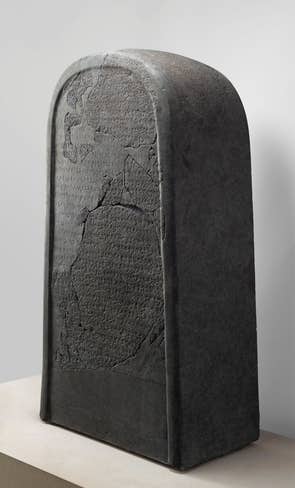By: Scott Reynolds, D.Min., Ph.D. | March 24, 2024
One of the most significant artifacts for Jews and Christians is the Mesha Stele or Moabite Stone, as it contains the first-known mention of Yahweh. The history of the artifact’s discovery is no less remarkable than its content. The inscription was first reported by an Alsatian missionary, who had seen it among the ruins of Dhiban, an ancient Moabite town east of the Dead Sea. Nearly 150 years ago, three Arab horsemen were galloping through the desert of Transjordan after completing a secret mission on behalf of a French diplomat stationed in Jerusalem. Local Bedouin had attacked them, injuring one of the riders, but they still got away with a priceless and significant prize: an archaeological treasure that would reform the way people viewed the history of the Bible, ancient Israel, and the way they interacted with Yahweh.
The Discovery of the Mesha Stele with the Name “Yahweh”
That treasure was a nearly 3,000-year-old inscription in which the king of Moab boasts of his victories against the Kingdom of Israel and its god YHWH. Called the Stele of Mesha, it contains the earliest known extrabiblical mention of the deity known as Yahweh (YHWH), worshipped by Jews, Christians, and Muslims. Since its discovery in 1868, it has fueled the argument over the historicity of the Bible.
At a time when amateur archaeologists and explorers were already scouring the Levant for evidence of the Bible’s historical accuracy, the news set off a race between colonial powers – mainly France, England, and Germany – to take possession of the stele. It was Charles Clermont-Ganneau, an archaeologist and diplomat at the French consulate in Jerusalem, who had sent those horsemen to take an impression, also known as a “squeeze,” of the text.
This was done by placing a wet paper sheet on the stone and pressing it into the indentations created by the letters. But while the paper was drying, Clermont-Ganneau’s envoys became involved in a brawl with a local Bedouin tribe. With their leader injured by a spear, they snatched the squeeze off the stone while it was still wet (tearing into several pieces in the process) before escaping. This act would prove vital for the preservation of the text because soon after, the Bedouin decided to destroy the stele, breaking it into dozens of fragments.
Some historians claim they did so because they believed there might be a treasure inside, but Richelle says it was likely an act of defiance toward the Ottoman authorities, who were pressuring the Bedouin to hand over the stone to Germany.
It took years for Clermont-Ganneau and other researchers to locate and acquire most of the fragments, but in the end the French scholar managed to piece together about two-thirds of the stele, reconstructing most of the missing parts thanks to the impression that had been so adventurously saved.[1]
The Content of the Mesha Stele with the Name “Yahweh”
In the text, King Mesha recounts how Israel had occupied the northern areas of his land and “oppressed Moab for a long time” under Omri and his son Ahab—the biblical monarchs who reigned from Samaria and made the Kingdom of Israel a powerful regional player in the first half of the ninth century BCE However, Mesha goes on to record how he rebelled against the Israelites, and conquered their strongholds and towns in Transjordan, including Nebo from whence he “took the vessels of YHWH and dragged them in front of Chemosh,” the main Moabite god.
When the Moabite Stone was found, it gave the solution to a question that had gone unanswered for centuries. The Bible states that David conquered Moab, that Solomon held Moab, and that Moab broke free at the outset of the divided kingdom. But the next biblical reference to Moab, 2 Kings 3:4, Ahab is receiving tribute from Moab. Nowhere does the Bible state how or when Moab was reclaimed for Ahab to be receiving such tribute. The Moabite Stone provides that information, telling, as it does, of Omri’s conquest from a Moabite point of view.[2]
Here is another artifact that works in harmony with the Bible. Each reveals part of the story, and only when they are brought together do they tell the whole story. While the Bible is limited with its records of the evil kings of the northern kingdom of Israel, there is enough information with the stele to understand the political climate during this period in Israel’s history. The blended account of Moab is a great example of the artifacts and the Bible working together to strengthen the history of Israel in the Levant.
Scholarly Interpretations of the Mesha Stele and Its Apologetic Attributes with the Name “Yahweh”
Critical scholars translate these records from the stele and conclude the God of Israel was weak and extremely different from what is detailed in the Bible. Yet, there is much to learn from the Stele and even more to use in apologetics.
The mention of Yahweh and its connection with Israel.
First, a great apologetic attribute is the mention of YHWH on the stele connecting Yahweh and Israel together. “Scholars have had the Bible for millennia, and parts of it are considered plausible by historians, but when you find an inscription that comes from the distant past, from the very time when these things happened, it suddenly become real,” says Matthieu Richelle, a professor of Hebrew Bible.[3]
The Mesha Stele reveals the consistency of God’s character.
Second, unbeknownst to Mesha he was revealing the consistency of the character of God. God’s people were defeated in the midst of their disobedience. The twist discovered on the stele is when the Moabite capital is about to fall, Mesha sacrifices his eldest son upon the walls, “and there was great indignation against Israel: and they departed from him and returned to their own land.” (2 Kings 3:27)
While the events narrated in the two texts appear quite different, “one of the most surprising aspects of Mesha’s inscription is how much it reads like a biblical chapter in style and language, scholars say.”[4] Mesha explains that the Israelite king Omri succeeded in conquering Moab only because “Chemosh was angry with his land” – a trope that finds many parallels in the Bible, where the Israelites’ misfortunes are invariably attributed to the wrath of God.
It is again Chemosh who decides to restore Moab to its people and speaks directly to Mesha, telling him, “Go take Nebo from Israel,” just as God routinely speaks to Israelite prophets and leaders in the Bible. And in conquering Nebo, Mesha recounts how he massacred the entire population as an act of dedication herem to his gods—the exact same word and brutal practice used in the Bible to describe the conquest of Canaan.
The consistency of the Scripture’s presentation of God.
Critical scholars only see a pattern of defeat caused by disobedience to a people’s god. Sadly, this pattern of Yahweh and Israel goes all the way back to the exodus. The consistent character of Yahweh in regard to obedience and disobedience of Israel is seen throughout the Bible. The apologist must deal with the critical response that every nation chalked up their losses to their own disobedience to their god. So, what makes Yahweh really any different? Other nations had prophets speaking on behalf of their gods, just as Israel had hers. In the time of the events, there seems to be no difference, and it, therefore, looks as if Yahweh is like the created gods of the other nations.
It is not until one can step back generations and see the overall character of God that Yahweh’s differences begin to emerge. When Jonah was sent to tell Nineveh that Yahweh had spoken of their destruction, or a herem over them unless they repented. Nineveh repented, and God relented from his wrath. Yahweh’s character must be taken as a whole to see the consistency of grace in the midst of obedience and punishment in the midst of disobedience. Critics and skeptics are going to focus on single events which mimic the nations around them. The best practice of an apologist is to follow the character of Yahweh from the beginning unto the life, death, and resurrection of Jesus.
About the Author
Scott Reynolds, D.Min., Ph.D.

Dr. Scott Reynolds earned his Ph.D. in Theology and Apologetics from Liberty University and his D.Min from New Orleans Baptist Theological Seminary. In addition to his doctoral accomplishments, he earned degrees from Troy University. Dr. Reynolds has traveled the world and has served as an archaeologist with some of the biggest names in the field. He brings a passion for biblical studies, biblical history, and an expertise in archaeological studies. Dr. Reynolds is a retired pastor and church planter. He has taught at New Orleans Baptist Theological Seminary and now is now working archaeological digs in a pursuit of discovering the apologetic properties of archaeology. Scott and his wife Lori have two grown children, one granddaughter and a very spoiled dog.
Notes
[1] Ariel David, “When God Wasn’t So Great: What Yahweh’s First Appearance Tells About Early Judaism,” Haaretz, September 13, 2018.
[2] Hoerth, Archaeology and the Old Testament.
[3] David, “When God Wasn’t So Great: What Yahweh’s First Appearance Tells About Early Judaism.”
[4] Ibid.
If you enjoyed this article, check out this one also written by the same author: https://bellatorchristi.com/2023/08/06/the-amarna-letters/
(c) 2024. Bellator Christi.





